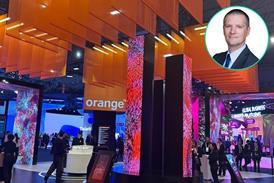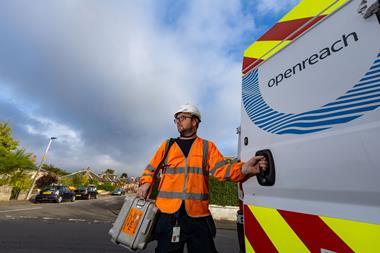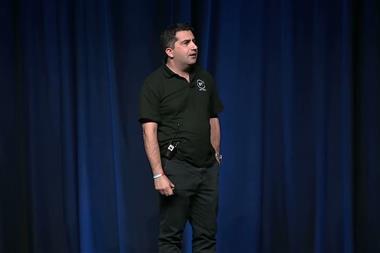- BT Chief Architect Campbell McClean says Digital and Networks teams operate with vendors in ‘grey space’, using language underpinned by TM Forum initiatives to support customers’ goals.
- Common lexicon provides platform for collaboration with partners, with Ciena’s Blue Planet among those namechecked in hosted podcast.
- McClean applying 20+ years of wide-ranging telco learnings in his new role at BT, with experience of Airtel and Telefónica particularly telling.

In recent years, BT Chief Architect and self-styled “custodian of BT’s digital technology” Campbell McClean has mapped a change in the telecoms industry from siloed network and digital teams to both working with the “grey space” between, allowing for collaboration in a common language.
McClean, who only joined BT in 2023 and took the Chief Architect mantle in June this year, reflected on more than two decades in the industry during a conversation with Kailem Anderson, who heads up Global Products & Delivery at partner Blue Planet, Ciena’s cloud-native OSS software arm.
He highlighted a change in telco culture as among the most significant developments.
“ I think that highly collaborative approach, where everybody comes to the table to give a win for the customer, is a change that I’ve seen happen over many years. So I can go back ten years, and the big joke in most telcos was that IT/digital and network were working two different functions, talking a completely different language. ”
McClean.
At BT, McClean’s remit is IT and Digital, while networks architecture is Chris Bramley’s domain. However, “we’re both focused on the same thing… focused on the customer”, McClean said.
McClean, Bramley, and their respective teams therefore operate in what he called a “grey space” between network and digital responsibilities, with customer outcomes the common ground.

McClean took over from Josie Smith as Chief Digital Architect in mid-2024, when Smith left for retailer Marks & Spencer, having spent the previous several months supporting the Digital team. Upon his elevation to Chief Architect, BT described McClean as “extremely experienced”, bringing with him a packed CV that includes some of the world’s largest telcos. He started in a transformation role at Orange before taking on the Chief Architect mantle at the UK’s EE (before it was acquired by BT), Spain’s Telefónica, India’s Bharti Airtel (a constituent of BT’s now leading strategic shareholder, Bharti Group), Germany’s Deutsche Telekom (BT’s second-largest shareholder), and then a slightly modified Vice-President, Enterprise Architecture spot at Canada’s Rogers Communications.
In a wide-ranging conversation with Blue Planet’s Anderson as part of the Ciena Insights Podcast series, McClean referred to his time at Telefónica and Airtel last decade, as particularly consequential in defining his view of what a telco should look like. He said he has taken lessons from this to implement a culture of inclusivity at BT. During time in Latin America with Telefónica, McClean learnt of the need to tap expertise across the organisation to adopt a ‘build once’ approach. While at Airtel (working under Harmeen Mehta, before she moved to BT and, just recently, left), he learnt the need to welcome diversity, focusing on whether team members “had value in delivery or didn’t”. He warned that if those around the decision-making table do not represent the population a telco serves, “you will underserve the customer. That is suboptimal”.
TM Forum defines ‘common lexicon’…
McClean went on to call out the role played by TM Forum in enabling the cultural shift, with common application programming interfaces (API) at its core.
Just this week, the industry body announced that BT has been accredited ‘Running on Open Digital Architecture’ (ODA) status for both its Consumer and Business divisions.
Speaking to TM Forum, BT Enterprise Architecture Director Colin Paterson said that the certification is “crucial” for a number of reasons, echoing McClean’s view that the adoption of a “shared language has enabled better communication between vendors, telcos, and partners”.
“ This common understanding helped us integrate vendor components and in-house solutions more efficiently. It also allows us to be more agile, which is essential for developing, delivering, and scaling new products and services quickly. ”
Paterson.
Along the same lines, McClean said TM Forum’s ODA and Open API model has provided telcos and the ecosystem in which they operate a “common framework and a common lexicon”, and as such helped build common ground where the end-user is the ultimate beneficiary.
He said BT’s adoption of ODA has ensured that digital/IT and network architects can “sit as a joint team” with vendors.
Paterson noted that BT has adopted 27 TM Forum APIs, “drastically” reducing integration efforts and allowing the Group to swap out vendors that do not “meet our standards” without disrupting BT operations.
… allowing BT and partners to focus on delivering what matters
Speaking on a Ciena-hosted podcast, McClean genially presented BT’s partnership with the network equipment provider’s vendor-neutral cloud-native OSS platform Blue Planet as a case-in-point.
He described the longstanding relationship as collaborative, with the common language “at the heart of our success”. It means that Blue Planet need not focus on delivering KPIs and service level agreements — “which are kind of table stakes” — for BT as a customer, but instead “you’re focused on giving a great experience to our [BT’s] customer”.
“ We have a commercial construct where the contract is never mentioned. It’s ‘whatever we got to do, we do together’. You realise value from that, and we realise value from that. ”
McClean.
McClean went on to comment on the Blue Planet platform — which has a “pretty good architecture and engineering construct” (architected by Anderson) — as an area in which BT and its partner are aligned. He described it as microservice-based, providing for rapid deployment of capabilities that can then be scaled and used elsewhere, feeding into BT’s aspiration to “build it once, use it many times”. “Our ambition with our engineering is to be building the same construct as you are”, he told Anderson.
BT’s relationship with Ciena goes back over 20 years, and in late-2023 Blue Planet was charged with a new role in supporting efforts to streamline systems, automate processes, and improve customer experience. The Group has worked to embrace Blue Planet’s cloud-native platform approach at BT Digital and made plans to expand the model to BT Business. Blue Planet was already in place to deliver BT Consumer’s EE Fibre products, along with elements of the former BT Enterprise architecture, and as an orchestrator within BT’s Network Cloud.
At BT, including Openreach, Blue Planet sits on a growing list of next-generation partners involved in the transformation of the operator’s IT estate and network operations, including:
- Adtran (optical transport).
- AWS (cloud services, AI).
- Blue Planet (network orchestration)
- Ciena (optical networking).
- Cisco (network infrastructure, including Global Fabric).
- Digital Realty (data centre connectivity).
- Dynatrace (AI-based automated fault detection).
- Ericsson (cloud-native 5G core).
- Equinix (data centre).
- Google Cloud (cloud services).
- Juniper (network cloud).
- Kyndryl (mainframe migration to the cloud).
- Microsoft (B2B growth, cloud, AI).
- Nokia (optical networking).
- SAP (IT modernisation).
- ServiceNow (workflow platform efficiencies).
- Tata Consultancy Services (tech debt, simplification).
- VMware (cloud-first).





































